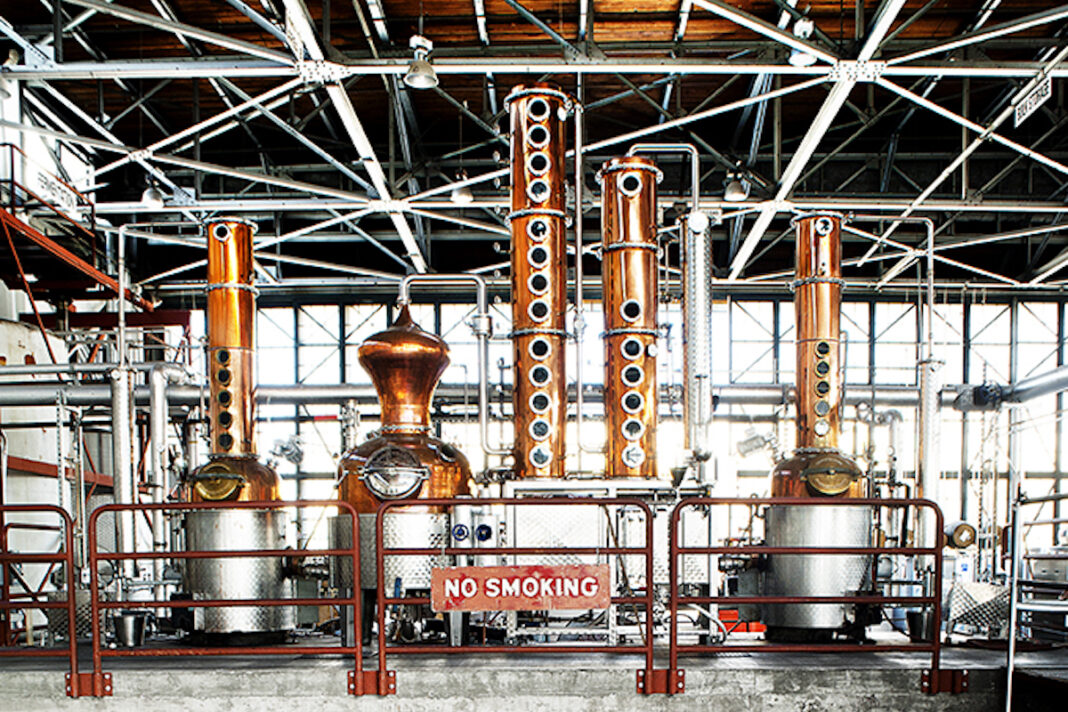Well into the 20th Century, an aging Frenchman recalled his youth and said that you hadn’t really lived unless you’d experienced the pleasure of undressing a woman in turn-of-the-century clothing, when one lacy layer gave way to another and the erotic tension mounted to a frenzy. Alas, one can’t help but think of Marcel Proust’s bittersweet discovery, made during the same era of corsets and petticoats, that anticipation is often more pleasurable than pleasure itself.
Absinthe, the signature drink of Belle Epoque France, also had a ritual based on delayed gratification, though one not nearly as complex as the jigsaw puzzle of women’s undergarments. The traditional way of drinking the moss-colored spirit—nicknamed “the green fairy” for the supposed buzz it brings—is to start by pouring an ounce of the potent potable in a glass. Next, perch on the rim, like a vulture hovering over your soon-to-be comatose self—a slotted spoon holding a sugar cube. Now, slowly pour ice water over the cube, which takes the sugar down into the glass, releases the oils of anise, fennel and wormwood, and turns the verdant elixir a cloudy white known as the louche.
The next part is easy: down the hatch. But be forewarned, overindulge and the green fairy may suddenly appear as a hologram-hallucination of Edgar Degas, who’s sketching your stone-faced expression for his famous 1876 painting, entitled simply Absinthe.
When an outbreak of phylloxera claimed nearly half the vineyards in France in the middle of the 19th Century, absinthe stepped in to fill the drinking void. When the wine industry recovered from the blight, it found it could not compete with the craze for absinthe, which appealed to bohemians and beau monde alike. And so it launched a propaganda campaign smearing absinthe as poison that will drive you mad. The United States banned the drink in 1912, and the ban stayed in effect until 2007.
Fifteen years later, the Bay Area is home to no less than four absinthe makers (not to mention the Absinthe Brasserie And Bar in San Francisco), each with its own special approach.
Oakland-based Absinthia Vermut was destined to become a follower of the green fairy. First off, that’s not her brand, but rather her actual name. Her family name was originally spelled Wermuth, she says, and the spirit known as vermouth originally contained wormwood, one of the defining botanicals in absinthe. She discovered the emerald elixir at the Burning Man festival in 1996, and immediately became obsessed with making it bootleg. Friends soon nicknamed her Absinthia, which is now her legal name, as well as the name of her eponymous brand.
“I call it traditional absinthe for Americans who didn’t grow up with a lot of anise on our palates,” she says. Her recipe is extra-smooth so that it doesn’t require any added sweetener, and is distilled in San Carlos by Coastal Spirits, an award-winning gin maker. “I like to shatter misconceptions and show people that absinthe, when well crafted, can be delicious,” Vermut says. “I felt like this is an amazing spirit that people need to understand is not dangerous or disgusting, and that’s what’s motivated me all these years to keep making it. ”
Vermut also offers a cocktail syrup called Fairy Dust, which she created after numerous acquaintances said they wanted a non-alcoholic absinthe alternative. It contains simple syrup flavored with the traditional ingredients anise, wormwood and fennel, and Vermut says it makes for an amazingly refreshing beverage when mixed with soda water and lemon juice.
Lance Winters “wanted to know what all the fuss was about” when it came to absinthe, and began tinkering with recipes after joining Alameda’s St. George Spirits in 1996. By the time the ban was lifted in 2007, says the master distiller and company president, “We had an absinthe that we really enjoyed, that was all about striking a balance between a group of really forward botanicals. It’s inspired by a traditional recipe, but rebalanced to something I really love to drink. Modern American drinkers aren’t huge fans of that black licorice profile, but the balance of mint and citrus that comes from the brandy base and the additional botanicals round that out. Our use of the non-traditional star anise gives more mouthfeel, and the opal basil draws the anise flavor to a different place.”
That different place isn’t Healdsburg. But up in the Wine Country you’ll find another one of the Bay Area’s devotees of the green fairy. The Young & Yonder distillery was founded in 2013 by husband and wife team Josh and Sarah Opatz, two former San Franciscans. After debuting with vodka and gin, the duo introduced an absinthe boasting a contemporary flavor profile. “We wanted to stay true to the spirit with anise, fennel and wormwood,” says Sarah Opatz, “but added lemongrass, ginger, peppermint and eucalyptus to make drinking it more interesting than just a black licorice bomb. We joke that ours is a gateway to absinthe.”
Caffeine and absinthe make for an interesting combination for adventurous drinkers. According to a toxicologist friend of Opatz, the spirit’s mysterious effect is not specifically from wormwood but rather the entire mix of ingredients—including the 120-proof alcohol—that “affects your nerves.” This is in perfect keeping with the fashion for nervous disorders that reigned during the French fin-de-siecle. But did absinthe soothe the nerves of jaded sophisticates facing the dawn of modernism, or cause their decadent neurasthenia? Most likely it was the green fairy flying a feedback loop, with absinthe alternately soothing nerves and revving them up.
As with anything, there are innovators and there are purists. Carter Raff, maker of San Francisco-based Emperor Norton absinthe, is the latter, and claims to be one of the few distilleries of the real deal. Given Emperor Norton’s 100-point score from Bonfort’s Wine and Spirits Journal, he may have a point. “Ninety percent of the absinthe out there isn’t made correctly,” says Raff. “I’ve been studying it since 1985. For one thing, most distilleries use star anise, which gives a heavy black licorice taste that numbs the tongue so you can’t taste the other herbs. I don’t know why some other makers even call it absinthe.”
Emperor Norton uses California grapes for its brandy base, and a Roman wormwood is added after the distilling to provide the natural green color that looks yellowish under light. “A lot of contemporary absinthes are neon green, which means they’ve been artificially colored, or they’re brown.” As for Roman wormwood, it’s only grown in the world for one reason and that’s coloring absinthe. Raff gets his from a small supplier in France that has been growing it for 150 years, but back in the bootleg days it was so expensive, he decided to grow his own.
“I got interested in absinthe because it was obscure and everything said about it was BS,” says Raff. “It never made you hallucinate or go crazy—that was all just propaganda by the French wine industry. I also like the ritual involved. You have to prepare it, like making espresso, devote time and attention to it and not just pour three fingers of whiskey and drink. Absinthe is something to cherish.”
Cherishing the green fairy—instead of provoking her—and absinthe can provide a night of elegant gaiety or quiet artistic creation, depending on what you ask of it. “The green fairy was a very poetic description of what one might experience after having some absinthe,” says St. George’s Lance Winters, “inspired by the beautiful, diaphanous swirls of opalescence in a glass, conjuring up the image of a fairy’s gown. But the toughest job of any honest absinthe producer is dispelling all of the myths around absinthe. What you should really expect is a complex spirit, with layers of complexity that slowly peel back after each sip to reveal a drink like no other.”











